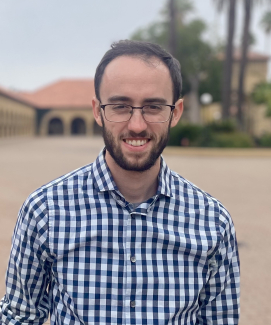Marsh
Brendan investigates many-body quantum physics with ultracold atoms and photons to realize novel quantum systems and harness them for practical or computational benefit. Before joining JILA as a post-doctoral researcher with Prof. Adam Kaufman and Prof. Cindy Regal, he completed his Ph.D. with Prof. Benjamin Lev at Stanford in the area of multimode cavity QED. His thesis presents the first realization of a quantum-optical associative memory neural network: a system made only of ultracold atoms and light which is able to store more than a dozen patterns as memories, and recall those memories even when presented with errors, achieving a form of pattern completion. His graduate work spans experimental and theoretical aspects of many-body physics, ranging from the theory of open quantum systems to realizing driven-dissipative spin glass models in condensed matter physics. He earned a master’s degree in applied mathematics and theoretical physics from the University of Cambridge, commonly known as Part III of the Mathematical Tripos, and received a BS in physics and mathematics from the University of Missouri in 2017, where he worked on experimental biophysics with Dr. Gavin King and designed the Hessian blob algorithm.
At JILA, Brendan works on the cryogenic Rydberg atom array experiment to push the limits on the generation of large-scale, defect-free atom arrays, explore the advantages afforded by reduced blackbody radiation at cryogenic temperatures, and harness those effects to realize novel quantum systems.



 The Physics Frontiers Centers (PFC) program supports university-based centers and institutes where the collective efforts of a larger group of individuals can enable transformational advances in the most promising research areas. The program is designed to foster major breakthroughs at the intellectual frontiers of physics by providing needed resources such as combinations of talents, skills, disciplines, and/or specialized infrastructure, not usually available to individual investigators or small groups, in an environment in which the collective efforts of the larger group can be shown to be seminal to promoting significant progress in the science and the education of students. PFCs also include creative, substantive activities aimed at enhancing education, broadening participation of traditionally underrepresented groups, and outreach to the scientific community and general public.
The Physics Frontiers Centers (PFC) program supports university-based centers and institutes where the collective efforts of a larger group of individuals can enable transformational advances in the most promising research areas. The program is designed to foster major breakthroughs at the intellectual frontiers of physics by providing needed resources such as combinations of talents, skills, disciplines, and/or specialized infrastructure, not usually available to individual investigators or small groups, in an environment in which the collective efforts of the larger group can be shown to be seminal to promoting significant progress in the science and the education of students. PFCs also include creative, substantive activities aimed at enhancing education, broadening participation of traditionally underrepresented groups, and outreach to the scientific community and general public.